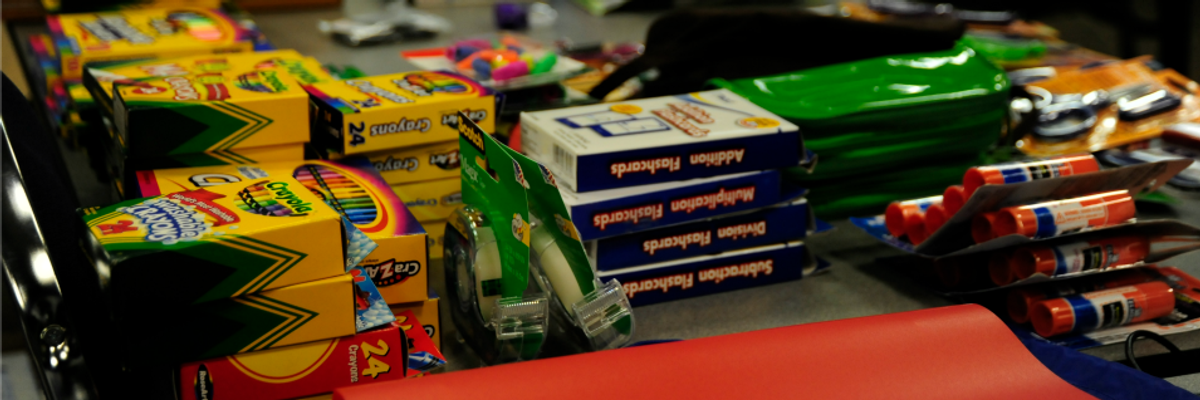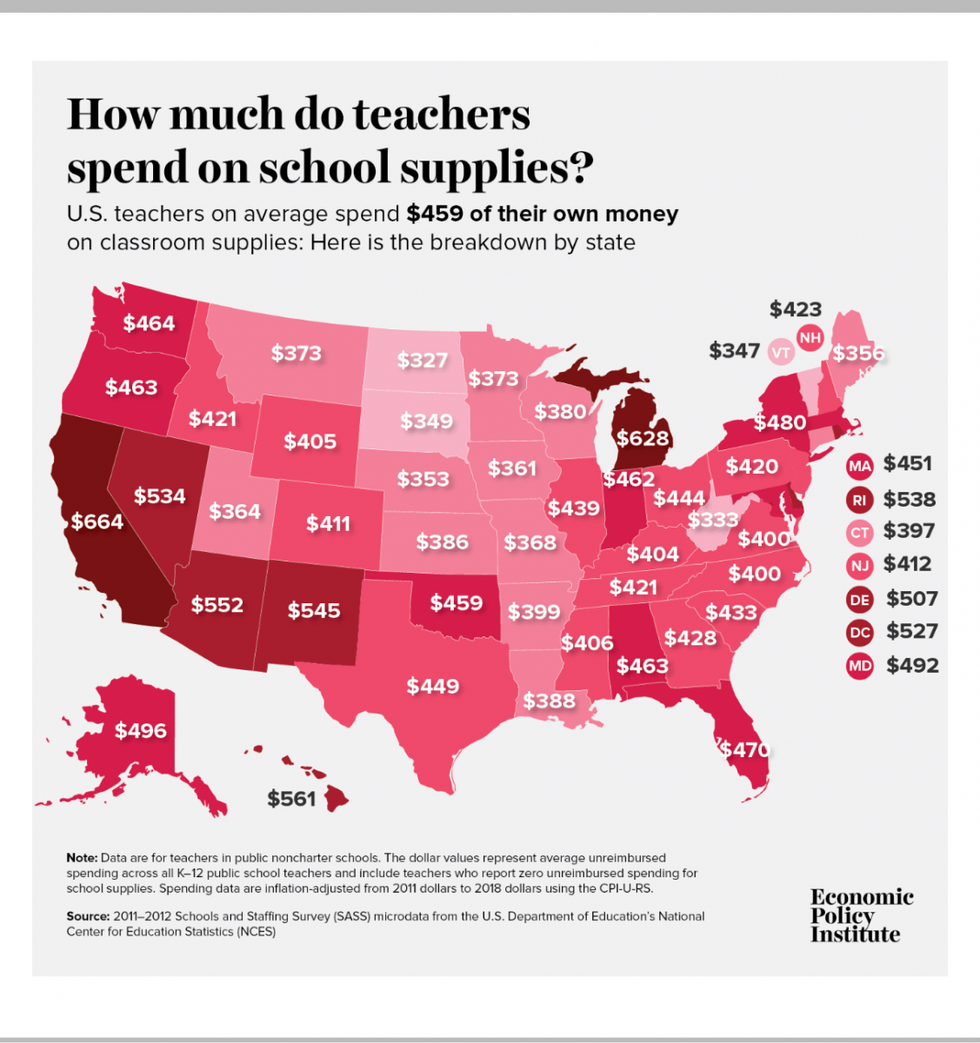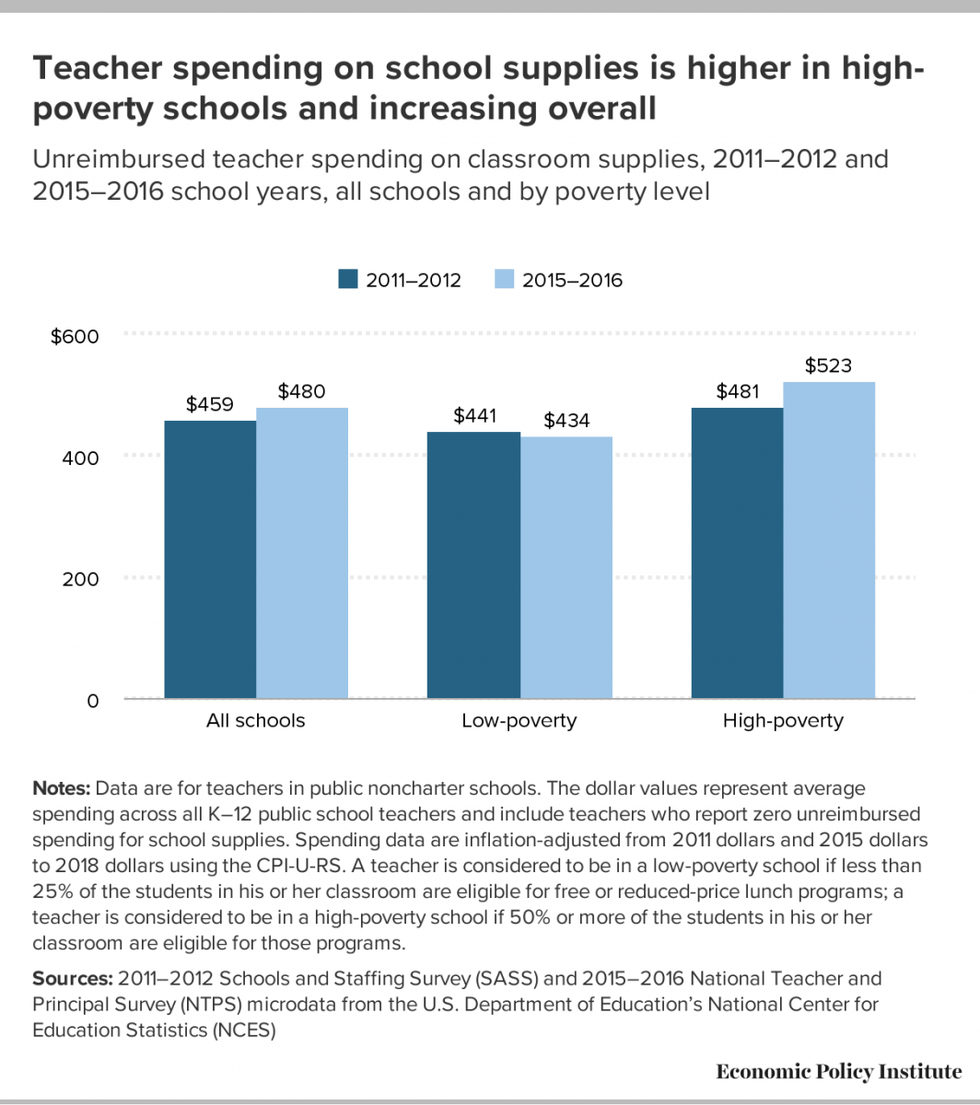

SUBSCRIBE TO OUR FREE NEWSLETTER
Daily news & progressive opinion—funded by the people, not the corporations—delivered straight to your inbox.
5
#000000
#FFFFFF
To donate by check, phone, or other method, see our More Ways to Give page.


Daily news & progressive opinion—funded by the people, not the corporations—delivered straight to your inbox.

School supplies are neatly stacked on a table at the 505th Command and Control wing headquarters at Hurlburt Field, Fla., August 16, 2011. 505th CCW Airmen donated school supplies to create back-to-school kits for children of the local community. (Photo: Airman Naomi M. Griego/U.S. Air Force)
As students, parents, and educators enter the start of a new school year, the think tank Economic Policy Institute published an analysis Thursday that American K-12 public school teachers spend an average of $459 on classroom supplies for which they are not reimbursed.
"There is no other profession I can think of where workers, as a matter of culture and practice, are relied upon to subsidize an employer's costs just so they can do their jobs."--Randi Weingarten, AFT"This figure does not include the dollars teachers spend but are reimbursed for by their school districts," EPI economist Emma Garcia wrote in a blog post. "The $459-per-teacher average is for all teachers, including the small (4.9 percent) share who do not spend any of their own money on school supplies."
EPI mapped teacher spending by state using survey data from the National Center for Education Statistics (NCES), adjusting for inflation figures from the 2011-2012 Schools and Staffing Survey to 2018 U.S. dollars. Unlike the center's 2015-2016 National Teacher and Principal Survey, the earlier survey includes state-level data.

"This variation should not be interpreted as a variation in teachers' altruism," Garcia noted. "State-by-state spending differences are likely due to a combination of factors, including students' needs, how schools are funded in the state, the cost of living in the state, and other factors."
\u201c"The dollar amounts and shares paint a unifying, generalized pattern of generosity across the country.\u201d— Economic Policy Institute (@Economic Policy Institute) 1566478679
"We know that the figures in the map are not an atypical high driven by the Great Recession because the 2011-2012 spending levels are lower than spending levels in the 2015-2016 NTPS data," Garcia explained. "The figure after the map shows that teachers' unreimbursed school supply spending has actually increased overall since the recovery."
In addition to the increase in out-of-pocket spending between 2011 and 2016, the NCES surveys show that teachers in high-poverty schools spend more than those in low-poverty schools. EPI's Garcia wrote that "this gap may reflect greater needs among students in high-poverty schools and more deficient funding systems for those schools."

Responding to EPI's report in a statement Thursday, American Federation of Teachers president Randi Weingarten said that "there is no other profession I can think of where workers, as a matter of culture and practice, are relied upon to subsidize an employer's costs just so they can do their jobs. But teachers want what kids need, so each year they buy hundreds of dollars' worth of supplies for their students without a second thought--even though they are paid over 20 percent less than similarly skilled professionals."
"Teachers care deeply about kids' learning and about creating safe and welcoming environments in their classrooms. They know that when there's no chalk or crayons, or tissues, or textbooks, when families are struggling to provide necessities, educators plug the gap," she added. "That's not to say it's right. But as long as their kids lack the essentials, educators will continue to dig deep. And they'll also join together to fight to fund our future, to fight the defunding and underinvestment that created this crisis in the first place."
Dear Common Dreams reader, The U.S. is on a fast track to authoritarianism like nothing I've ever seen. Meanwhile, corporate news outlets are utterly capitulating to Trump, twisting their coverage to avoid drawing his ire while lining up to stuff cash in his pockets. That's why I believe that Common Dreams is doing the best and most consequential reporting that we've ever done. Our small but mighty team is a progressive reporting powerhouse, covering the news every day that the corporate media never will. Our mission has always been simple: To inform. To inspire. And to ignite change for the common good. Now here's the key piece that I want all our readers to understand: None of this would be possible without your financial support. That's not just some fundraising cliche. It's the absolute and literal truth. We don't accept corporate advertising and never will. We don't have a paywall because we don't think people should be blocked from critical news based on their ability to pay. Everything we do is funded by the donations of readers like you. Will you donate now to help power the nonprofit, independent reporting of Common Dreams? Thank you for being a vital member of our community. Together, we can keep independent journalism alive when it’s needed most. - Craig Brown, Co-founder |
As students, parents, and educators enter the start of a new school year, the think tank Economic Policy Institute published an analysis Thursday that American K-12 public school teachers spend an average of $459 on classroom supplies for which they are not reimbursed.
"There is no other profession I can think of where workers, as a matter of culture and practice, are relied upon to subsidize an employer's costs just so they can do their jobs."--Randi Weingarten, AFT"This figure does not include the dollars teachers spend but are reimbursed for by their school districts," EPI economist Emma Garcia wrote in a blog post. "The $459-per-teacher average is for all teachers, including the small (4.9 percent) share who do not spend any of their own money on school supplies."
EPI mapped teacher spending by state using survey data from the National Center for Education Statistics (NCES), adjusting for inflation figures from the 2011-2012 Schools and Staffing Survey to 2018 U.S. dollars. Unlike the center's 2015-2016 National Teacher and Principal Survey, the earlier survey includes state-level data.

"This variation should not be interpreted as a variation in teachers' altruism," Garcia noted. "State-by-state spending differences are likely due to a combination of factors, including students' needs, how schools are funded in the state, the cost of living in the state, and other factors."
\u201c"The dollar amounts and shares paint a unifying, generalized pattern of generosity across the country.\u201d— Economic Policy Institute (@Economic Policy Institute) 1566478679
"We know that the figures in the map are not an atypical high driven by the Great Recession because the 2011-2012 spending levels are lower than spending levels in the 2015-2016 NTPS data," Garcia explained. "The figure after the map shows that teachers' unreimbursed school supply spending has actually increased overall since the recovery."
In addition to the increase in out-of-pocket spending between 2011 and 2016, the NCES surveys show that teachers in high-poverty schools spend more than those in low-poverty schools. EPI's Garcia wrote that "this gap may reflect greater needs among students in high-poverty schools and more deficient funding systems for those schools."

Responding to EPI's report in a statement Thursday, American Federation of Teachers president Randi Weingarten said that "there is no other profession I can think of where workers, as a matter of culture and practice, are relied upon to subsidize an employer's costs just so they can do their jobs. But teachers want what kids need, so each year they buy hundreds of dollars' worth of supplies for their students without a second thought--even though they are paid over 20 percent less than similarly skilled professionals."
"Teachers care deeply about kids' learning and about creating safe and welcoming environments in their classrooms. They know that when there's no chalk or crayons, or tissues, or textbooks, when families are struggling to provide necessities, educators plug the gap," she added. "That's not to say it's right. But as long as their kids lack the essentials, educators will continue to dig deep. And they'll also join together to fight to fund our future, to fight the defunding and underinvestment that created this crisis in the first place."
As students, parents, and educators enter the start of a new school year, the think tank Economic Policy Institute published an analysis Thursday that American K-12 public school teachers spend an average of $459 on classroom supplies for which they are not reimbursed.
"There is no other profession I can think of where workers, as a matter of culture and practice, are relied upon to subsidize an employer's costs just so they can do their jobs."--Randi Weingarten, AFT"This figure does not include the dollars teachers spend but are reimbursed for by their school districts," EPI economist Emma Garcia wrote in a blog post. "The $459-per-teacher average is for all teachers, including the small (4.9 percent) share who do not spend any of their own money on school supplies."
EPI mapped teacher spending by state using survey data from the National Center for Education Statistics (NCES), adjusting for inflation figures from the 2011-2012 Schools and Staffing Survey to 2018 U.S. dollars. Unlike the center's 2015-2016 National Teacher and Principal Survey, the earlier survey includes state-level data.

"This variation should not be interpreted as a variation in teachers' altruism," Garcia noted. "State-by-state spending differences are likely due to a combination of factors, including students' needs, how schools are funded in the state, the cost of living in the state, and other factors."
\u201c"The dollar amounts and shares paint a unifying, generalized pattern of generosity across the country.\u201d— Economic Policy Institute (@Economic Policy Institute) 1566478679
"We know that the figures in the map are not an atypical high driven by the Great Recession because the 2011-2012 spending levels are lower than spending levels in the 2015-2016 NTPS data," Garcia explained. "The figure after the map shows that teachers' unreimbursed school supply spending has actually increased overall since the recovery."
In addition to the increase in out-of-pocket spending between 2011 and 2016, the NCES surveys show that teachers in high-poverty schools spend more than those in low-poverty schools. EPI's Garcia wrote that "this gap may reflect greater needs among students in high-poverty schools and more deficient funding systems for those schools."

Responding to EPI's report in a statement Thursday, American Federation of Teachers president Randi Weingarten said that "there is no other profession I can think of where workers, as a matter of culture and practice, are relied upon to subsidize an employer's costs just so they can do their jobs. But teachers want what kids need, so each year they buy hundreds of dollars' worth of supplies for their students without a second thought--even though they are paid over 20 percent less than similarly skilled professionals."
"Teachers care deeply about kids' learning and about creating safe and welcoming environments in their classrooms. They know that when there's no chalk or crayons, or tissues, or textbooks, when families are struggling to provide necessities, educators plug the gap," she added. "That's not to say it's right. But as long as their kids lack the essentials, educators will continue to dig deep. And they'll also join together to fight to fund our future, to fight the defunding and underinvestment that created this crisis in the first place."